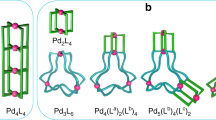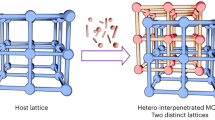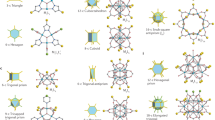Abstract
Metal–organic frameworks form a unique class of multifunctional hybrid materials and have myriad applications, including gas storage and catalysis. Their structure is usually achieved through the infinite coordination of metal ions and multidentate organic ligands by means of strong covalent bonds. Threaded molecules such as catenanes and rotaxanes have largely been restricted to comprising components of two-dimensional interlocking rings or polygons. There are very few examples of the catenation of polyhedral cages. Although it has been postulated that the infinite extended architecture can be obtained from the polycatenation of a discrete cage based on such threading, this has not been documented to date. Here we describe an infinite three-dimensional metal–organic framework composed of catenated polyhedral cages, in which the framework is achieved by mechanical interlocking of all of the vertices of the cages. The three-dimensional polycatenated framework shows twofold self-interpenetration in its crystal packing. The penetration of polycatenanes creates nanosized voids into which the Keggin polyoxometalate anions are perfectly accommodated as counteranions.
This is a preview of subscription content, access via your institution
Access options
Subscribe to this journal
Receive 12 print issues and online access
$259.00 per year
only $21.58 per issue
Buy this article
- Purchase on Springer Link
- Instant access to full article PDF
Prices may be subject to local taxes which are calculated during checkout





Similar content being viewed by others
Change history
24 May 2010
An incorrect version of Fig. 1 appeared temporarily in this HTML Article in the June issue. This has now been corrected; it is correct in the PDF and in print.
References
Balzani, V., Credi, A. & Venturi, M. Molecular Devices and Machines—Concepts and Perspectives for the Nanoworld (Wiley-VCH, 2008).
Balzani, V., Credi, A., Raymo, F. M. & Stoddart, J. F. Artificial molecular machines. Angew. Chem. Int. Ed. 39, 3348–3391 (2000).
Hernández, J. V., Kay, E. R. & Leigh, D. A. A reversible synthetic rotary molecular motor. Science 306, 1532–1537 (2004).
Wang, L., Vysotsky, M. O., Bogdan, A., Bolte, M. & Böhmer, V. Multiple catenanes derived from calix[4]arenes. Science 304, 1312–1314 (2004).
Serreli, V., Lee, C.-F., Kay, E. R. & Leigh, D. A. A molecular information ratchet. Nature 445, 523–527 (2007).
Flood, A. H., Stoddart, J. F., Steuerman, D. W. & Heath, J. R. Whence molecular electronics? Science 306, 2055–2056 (2004).
Balzani, V., Credi, A. & Venturi, M. Light powered molecular machines. Chem. Soc. Rev. 38, 1542–1550 (2009).
Mullen, K. M. & Beer, P. D. Sulfate anion templation of macrocycles, capsules, interpenetrating and interlocked structures. Chem. Soc. Rev. 38, 1701–1713 (2009).
Lehn, J.-M. Toward self-organization and complex matter. Science 295, 2400–2403 (2002).
Reinhoudt, D. N. & Crego-Calama, M. Synthesis beyond the molecule. Science 295, 2403–2407 (2002).
Ikkala, O. & Brinke, G. Functional materials based on self-assembly of polymeric supramolecules. Science 295, 2407–2409 (2002).
Collier, C. P. et al. A [2]catenane-based solid state electronically reconfigurable switch. Science 289, 1172–1175 (2000).
Stoddart, J. F. The chemistry of mechanical bond. Chem. Soc. Rev. 38, 1802–1820 (2009).
Wikoff, W. R. et al. Topologically linked protein rings in the bacteriophage HK97 capsid. Science 289, 2129–2133 (2000).
Rybenkov, V. V., Ullsperger, C., Vologodskii, A.V. & Cozzarelli, N. R. Simplification of DNA topology below equilibrium values by type II topoisomerases. Science 277, 690–693 (1997).
Fuller, A.-M. L., Leigh, D. A., Lusby, P. J., Slawin, A. M. Z. & Walker, D. B. Selecting topology and connectivity through metal-directed macrocyclization reactions: a square planar palladium [2]catenate and two noninterlocked isomers. J. Am. Chem. Soc. 127, 12612–12619 (2005).
Fujita, M., Fujita, N., Ogura, K. & Yamaguchi, K. Spontaneous assembly of ten components into two interlocked, identical coordination cages. Nature 400, 52–55 (1999).
Westcott, A., Fisher, J., Harding, L. P., Rizkallah, P. & Hardie, M. J. Self-assembly of a 3-D triply interlocked chiral [2]catenane. J. Am. Chem. Soc. 130, 2950–2951 (2008).
Saalfrank, R. W., Stark, A., Peters, K. & Schnering, H. G. The first ‘adamantoid’ alkaline earth metal chelate complex: synthesis, structure, and reactivity. Angew. Chem. Int. Ed. Engl. 27, 851–853 (1988).
Beissel, T., Powers, R. E. & Raymond, K. N. Symmetry-based metal complex cluster formation. Angew. Chem. Int. Ed. Engl. 35, 1084–1086 (1996).
Fujita, M., Tominaga, M., Hori, A. & Therrien, B. Coordination assemblies from a Pd (II)-cornered square complex. Acc. Chem. Res. 38, 371–380 (2005).
Leininger, S., Olenyuk, B. & Stang, P. J. Self-assembly of discrete cyclic nanostructures mediated by transition metals. Chem. Rev. 100, 853–908 (2000).
Seidel, S. R. & Stang, P. J. High-symmetry coordination cage via self-assembly. Acc. Chem. Res. 35, 972–983 (2002).
Cotton, F. A., Murillo, C. A. & Yu, R. Deliberate synthesis of the preselected enantiomer of an enantiorigid molecule with pure rotational symmetry T. Dalton Trans. 3161–3165 (2005).
Tranchemontagne, D. J., Ni, Z., O'Keeffe, M. & Yaghi, O. M. Reticular chemistry of metal–organic polyhedra. Angew. Chem. Int. Ed. 47, 5136–5147 (2008).
Carlucci, L., Ciani, G. & Proserpio, D. M. Polycatenation, polythreading and polyknotting in coordination network chemistry. Coord. Chem. Rev. 246, 247–289 (2003).
Zhai, Q.-G., Wu, X.-Y., Chen, S.-M., Zhao, Z.-G. & Lu, C.-Z. Construction of Ag/1,2,4-triazole/polyoxometalates hybrid family varying from diverse supramolecular assemblies to 3-D rod-packing framework. Inorg. Chem. 46, 5046–5058 (2007).
Fujita, M. et al. Self-assembly of ten molecules into nanometre-sized organic host frameworks. Nature 378, 469–471 (1995).
Lu, J. et al. Octapi interactions: self-assembly of a Pd-based [2]catenane driven by eightfold π interactions. J. Am. Chem. Soc. 131, 10372–10373 (2009).
Codina, A. et al. Do aurophilic interactions compete against hydrogen bonds? Experimental evidence and rationalization based on ab initio calculations. J. Am. Chem. Soc. 124, 6781–6786 (2002).
Zhang, J.-P., Lin, Y.-Y., Huang, X.-C. & Chen, X.-M. Copper (I) 1,2,4-triazolates and related complexes: studies of the solvothermal ligand reactions, network topologies, and photoluminescence properties. J. Am. Chem. Soc. 127, 5495–5506 (2005).
Acknowledgements
This work was supported by the 973 Key Program of the Ministry of Science and Technology of China (2006CB932904, 2007CB815304 and 2010CB933501), the National Natural Science Foundation of China (20873150, 50772113, 20821061 and 20973173), the Chinese Academy of Sciences (KJCX2-YW-M05, 319) and the National Science Foundation (CHE-0845829; J.P.D.).
Author information
Authors and Affiliations
Contributions
X.K. and C.Z.L. conceived and designed the experiments. X.K. performed the experimental work. X.K., X.W., R.Y., J.H. and C.Z.L. analysed the X-ray structural data and interpreted the results. C.Z.L. was responsible for the overall design, direction and supervision of the project. X.K., R.Y., J.P.D. and C.Z.L. co-wrote the paper.
Corresponding author
Ethics declarations
Competing interests
The authors declare no competing financial interests.
Supplementary information
Supplementary information
Supplementary information (PDF 891 kb)
Supplementary information
Crystallographic data for compound 1 (CIF 15 kb)
Rights and permissions
About this article
Cite this article
Kuang, X., Wu, X., Yu, R. et al. Assembly of a metal–organic framework by sextuple intercatenation of discrete adamantane-like cages. Nature Chem 2, 461–465 (2010). https://doi.org/10.1038/nchem.618
Received:
Accepted:
Published:
Issue Date:
DOI: https://doi.org/10.1038/nchem.618
This article is cited by
-
Catenated covalent organic frameworks constructed from polyhedra
Nature Synthesis (2023)
-
Kinetic trapping of 2,4,6-tris(4-pyridyl)benzene and ZnI2 into M12L8 poly-[n]-catenanes using solution and solid-state processes
Scientific Reports (2023)
-
Directed synthesis of a new decamolybdate-encapsulated nanocage framework by mixed-ligands for light-driven hydrogen generation
Clean Technologies and Environmental Policy (2022)
-
Solvent-Mediated 1,ω-Bis(isoquinoline)alkane/Iodobismuthate Hybridized Isomers: Structures and Packing Mode Dependent-Photoluminescence/Thermochromisms
Journal of Cluster Science (2021)
-
A Silicotungstate-Based Silver(I) Compound with Octanuclear Core: Synthesis, Crystal Structure and Luminescent Property
Journal of Cluster Science (2019)



